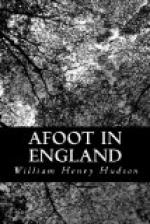A thaw had come that morning, ending the severest frost experienced this winter anywhere in England, and the valley was alive with birds, happy and tuneful at the end of January as in April. Looking down on the stream the sudden glory of a kingfisher passed before me; but the sooty-brown water-ouzel with his white bib, a haunter, too, of this water, I did not see. Within a mile or so of Wells I overtook a small boy who belonged there, and had been to Shepton like me, noticing the birds. “I saw a kingfisher,” I said. “So did I,” he returned quickly, with pride. He described it as a biggish bird with a long neck, but its colour was not blue—oh, no! I suggested that it was a heron, a long-necked creature under six feet high, of no particular colour. No, it was not a heron; and after taking thought, he said, “I think it was a wild duck.”
Bestowing a penny to encourage him in his promising researches into the feathered world, I went on by a footpath over a hill, and as I mounted to the higher ground there before me rose the noble tower of St. Cuthbert’s Church, and a little to the right of it, girt with high trees, the magnificent pile of the cathedral, with green hills and the pale sky beyond. O joy to look again on it, to add yet one more enduring image of it to the number I had long treasured! For the others were not exactly like this one; the building was not looked at from the same point of view at the same season and late hour, with the green hills lit by the departing sun and the clear pale winter sky beyond.
Coming in by the moated palace I stood once more on the Green before that west front, beautiful beyond all others, in spite of the strange defeatures Time has written on it. I watched the daws, numerous as ever, still at their old mad games, now springing into the air to scatter abroad with ringing cries, only to return the next minute and fling themselves back on their old perches on a hundred weather-stained broken statues in the niches. And while I stood watching them from the palace trees close by came the loud laugh of the green woodpecker. The same wild, beautiful sound, uttered perhaps by the same bird, which I had often heard at that spot ten years ago! “You will not hear that woodland sound in any other city in the kingdom,” I wrote in a book of sketches entitled “Birds and Man”, published in 1901.
But of my soul’s adventures in Wells on the two or three following days I will say very little. That laugh of the woodpecker was an assurance that Nature had suffered no change, and the town too, like the hills and rocks and running waters, seemed unchanged; but how different and how sad when I looked for those I once knew, whose hands I had hoped to grasp again! Yes, some were living still; and a dog too, one I used to take out for long walks and many a mad rabbit-hunt—a very handsome white-and-liver coloured spaniel. I found him lying on a sofa, and down he got and wagged his tail vigorously, pretending, with a pretty human hypocrisy in his gentle yellow eyes, that he knew me perfectly well, that I was not a bit changed, and that he was delighted to see me.




